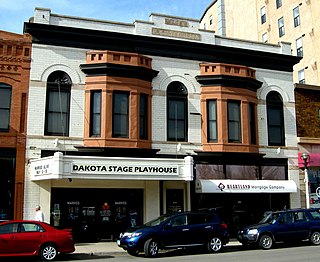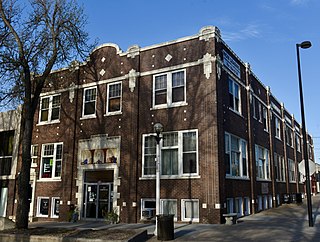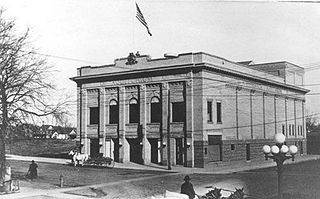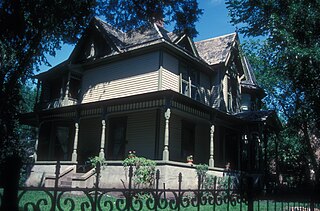
There are 461 properties and historic districts listed on the National Register of Historic Places in North Dakota. There are listings in 52 of North Dakota's 53 counties.

This is a list of the National Register of Historic Places listings in Burleigh County, North Dakota.

This is a list of the National Register of Historic Places listings in Cass County, North Dakota.
The Soo Hotel was later known as the Princess Hotel, The Patterson Hotel Annex, The Hotel Dakotan, Heritage Recovery Center, and Heritage Apartments. It is a historic building located on Fifth Street North in Bismarck, North Dakota, United States, and was listed on the National Register of Historic Places in 1983. It was built by prominent businessman and political powerhouse Edward Patterson in 1906 as a second-class hotel to his other property, the high-class Northwestern Hotel. The four-floor, 76-room hotel was named after the Soo Line Railroad which had arrived in town in 1902 and whose depot was located several blocks away. It was briefly the tallest building in Bismarck.

The U.S. Post Office and Courthouse in Bismarck, North Dakota, United States, was built during 1912–13 and expanded in 1937. It was designed by James Knox Taylor and includes Late 19th and 20th Century Revivals architecture and Second Renaissance Revival architecture. Also known as Federal Building, it served historically as a courthouse and as a post office. The building was listed on the National Register of Historic Places in 1976.

The Bismarck station in Bismarck, North Dakota was built in 1900 by the Northern Pacific Railway. It is in Mission/Spanish Revival style and was designed by architects Reed & Stem. It "is notable for its Spanish mission-style architecture, a familiar mode in the Southwest and California but uncommon in the northern plains." After the Northern Pacific Railway and then Burlington Northern Railroad discontinued passenger service, Amtrak's North Coast Hiawatha used the station from 1971 until it was discontinued in 1979.

The Liberty Memorial Bridge, across the Missouri River connecting the "twin cities" of Bismarck and Mandan, North Dakota, also known as Missouri River Bridge, was a Warner-Turner through truss structure that was built in 1920. It was listed on the National Register of Historic Places in 1997. It was replaced by a new bridge in 2008 and removed from the National Register in 2009.
Yegen House and Pioneer Grocery, in Bismarck, North Dakota, was listed on the National Register of Historic Places. It was built in 1874. The owner John Yegen was an immigrant from Switzerland. The listing, in 1977, included three contributing buildings. The site was delisted in 2011, due to the house being demolished and the Grocery being relocated to the Missouri Valley Fairgrounds in 1993.

The E. G. Patterson Building at 412–414 Main St. in Bismarck, North Dakota, United States, was built in 1905. It was listed on the National Register of Historic Places in 1982.

The Bismarck Tribune Building on N. 4th St. in Bismarck, North Dakota was designed by architect George H. Shanley and was built in 1920.

The Bismarck Cathedral Area Historic District, also known as The Hill, is a historic district that is listed on the National Register of Historic Places (NRHP). A first 27.3-acre (11.0 ha) area was NRHP-listed in 1980. The original listing included 47 contributing buildings, including the Cathedral of the Holy Spirit. The district was increased by 15 acres (6.1 ha) with 40 contributing buildings and one contributing site in 1997. The district was further changed in 2010 by subtraction of some buildings and properties, and by the addition of others.

The Bismarck Civic Auditorium on North 6th Street in Bismarck, North Dakota, was built in 1914. It has also been known as City Auditorium. It was listed on the National Register of Historic Places in 1976.
Arthur Wesley Van Horn was a prolific architect of Bismarck, North Dakota. A number of Van Horn's works, alone or as part of his firm, are listed on the U.S. National Register of Historic Places.

The Dr. Albert M. and Evelyn M. Brandt House on E. Ave. B in Bismarck, North Dakota was built in 1928. It has also been known as the Francis and Leona Larson House. It was listed on the National Register of Historic Places (NRHP) in 2000; the listing included two contributing buildings and a contributing site.
The Webb Brothers Block on E. Main Ave. in Bismarck, North Dakota has also been known as the Sears Block. The building was built in 1898–1899 with an addition added in 1906. It was listed on the National Register of Historic Places in 1983.

The Towne–Williams House on 7th St., N., in Bismarck, North Dakota was built in 1885. It has also been known as the George W. Wallace House and as the Erastus A. Williams House. It was listed on the National Register of Historic Places (NRHP) in 1975.

Camp Hancock Site on Main Ave. in Bismarck, North Dakota was built in 1872. It has also been known as Camp Hancock Historic Site and as Camp Hancock. It was listed on the National Register of Historic Places in 1972.
The Downtown Bismarck Historic District is a 40-acre (16 ha) historic district in Bismarck, North Dakota that was listed on the National Register of Historic Places in 2001. It includes work by architect Arthur Van Horn and others. The listing included 40 contributing buildings.

The Our Lady of the Annunciation Chapel at Annunciation Priory in Bismarck, North Dakota, was listed on the National Register of Historic Places in 2020. It is located at 7500 University Drive and is the chapel of University of Mary.
















